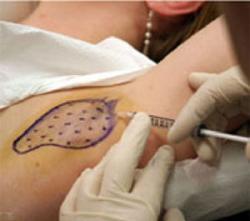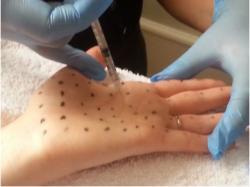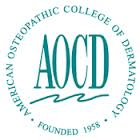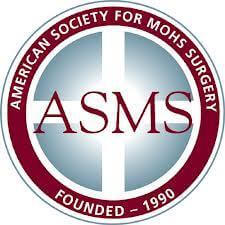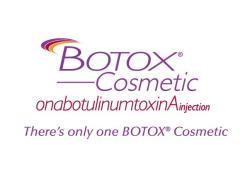
Oakland Hills Dermatology is the premier location for your Botox® Cosmetic needs. Botox® Cosmetic is a popular non-surgical injection that effectively reduces frown lines, forehead creases, crow’s feet near the eyes and thick bands in the neck. Botox® Cosmetic’s unique protein complex blocks the nerve impulses, temporarily relaxing the muscles that cause wrinkles while giving the skin a smoother, more refreshed appearance.
After the treatment, it will take 3-10 days to notice the immobilizing of the muscle. Botox® Cosmetic is not permanent, but the results will last approximately three to four months.
Booking your favorite treatments just got easier and more affordable with our Cherry Financing options! Book your treatment today and enjoy low monthly payment plans.
Call today to schedule a cosmetic dermatology consultation
Botox® blocks impulses from the nerve to the tiny facial muscles that are related to expression lines. Botox® also relaxes the muscles so you look more relaxed. After your treatment, the overlying skin remains smooth and unwrinkled.
Treatment with Botox® is a simple and safe procedure. A very small amount of Botox® is injected very precisely into several areas. Many patients compare the sensation to a little sting. No sedation or local anesthetic is required, and you can resume normal activities immediately. You can even drive yourself home or back to the office. Some patients may experience a slight temporary bruising at the injection site which can be easily covered with make-up.
Botox® injections have been used safely and effectively for over thirty years to treat many other medical conditions. Each year thousands of patients receive Botox® treatments for a variety of conditions and it is the most popular treatment for reversing the visible signs of aging.
Anyone who is concerned about preventing wrinkles and deep furrows.
- People who are pregnant or plan to become pregnant or currently breastfeeding.
- had an allergic reaction to any other botulinum toxin product such as Myobloc® or Dysport®
- have a skin infection at the planned injection site
- You should not be treated with Botox® Cosmetic if you have:
- a disease that affects your muscles and nerves (such as amyotrophic lateral sclerosis [ALS or Lou Gehrig’s disease], myasthenia gravis or Lambert-Eaton syndrome).
- a breathing problem, such as asthma or emphysema
- swallowing problems
- bleeding problems
- plans to have surgery
- had surgery on your face
- weakness of your forehead muscles, such as trouble raising your eyebrows
- drooping eyelids
- any other change in the way your face normally looks
The treatment is not permanent. The results will last approximately 3-4 months.
After the treatments, it will take 3-10 days to notice the immobilizing of the muscle.
Depending on the severity of the area, with time, furrows and wrinkles can be diminished. Some other options may be needed to meet the patient’s expectations
There is little to none. Makeup may be applied directly afterwards.
There may be some slight bruising at the injection site. Depending on where the Botox® is placed there can be a slight drooping of one eyelid that may last 2-3 weeks. You may experience headaches, some numbness and slight swelling.
The area will be cleansed, then Botox® is injected to the target areas with a very fine needle. It takes only a few minutes, with mild discomfort. Cold packs may be placed on the area afterwards to minimize bruising and swelling.
Before and after treatment aspirin, ibuprofen, and vitamin E should be avoided for a week. Patients should not lie down for 4 hours afterwards.
~~BEFORE AND AFTER GALLERY~~
BOTOX ® FOR HYPERHIDROSIS (EXCESSIVE SWEATING) OF THE UNDERARMS, PALMS, AND FEET
Botox for Hyperhidrosis is a popular non-surgical treatment that may be used for excessive sweating in the underarms, hands, and feet. If underarm, hand or feet sweating is significantly interfering with your daily activities and topical agents haven’t worked, you may be a candidate for Botox® treatment. You should notice a significant reduction in underarm sweating within 4 weeks of your first treatment. Results from Botox® for Hyperhidrosis will last approximately 6 months.
Excessive sweating of the underarms, palms, and soles is a widespread problem that significantly affects a person’s ability to function in personal and business settings. The main cause of excessive sweating is overactive sweat glands. Sweat is your body’s temperature regulator. In severe hyperhidrosis, sweating significantly exceeds the body’s normal requirements for cooling.
Botox® is a very effective approach for the treatment of hyperhidrosis. Botox® was FDA approved for underarm sweating several years ago and works very well. It can also be used to treat excessive sweating of the palms and soles. Treatment is performed in the office and takes about 20 minutes. Results are often dramatic, especially in the axillae, and usually last 6 – 8 months. Effects start to appear in 3 – 4 days and peak in about 2 weeks.
Call today to schedule a cosmetic dermatology consultation.
What Is Treatment With Botox® Like?
The procedure is relatively straightforward. A small volume of Botox® solution is injected into the affected underarm area through a very fine needle. The needle is placed just under the skin, so you may experience some injection-related discomfort. You will receive multiple injections based on your doctor’s assessment of the area that needs to be treated. You will notice effects in 24 to 72 hours.
EVERY DAY TIPS FOR NON-MEDICAL HELP IN CONTROLLING EXCESSIVE SWEATING
While only a doctor can prescribe or perform certain hyperhidrosis treatments, there are things you can do to help make excessive sweating less of a burden on your everyday life:
- Bathe daily to keep the amount of bacteria on your skin in check.
- Dry yourself thoroughly after you bathe. Bacteria and fungi (which can cause body odor and infections on irritated skin) thrive in damp spaces, like between your toes. If you have sweaty feet, use foot powders to help absorb sweat.
- Apply antiperspirant products in the evening. Antiperspirants may be used on hands and feet as well as on underarms. Gently massaging them into the skin may be useful. Follow instructions carefully if using prescription antiperspirants.
- Wear natural fabrics, such as cotton, wool, and silk, which allow your skin to breathe. When you exercise, you might prefer high-tech fabrics that wick moisture away from your skin.
- “Dress shields,” small pads that go in your armpits to absorb sweat, may be an option for you. You may also want to keep an extra shirt with you for emergencies.
- Launder your clothes and/or change your shoes and clothing often.
- If you have trouble with sweaty feet, rotate your shoes. Your shoes may not dry out overnight, so try not to wear the same pair two days in a row. If you have shoes with removable insoles, change those often. Many athletic shoes can be machine washed and dried in the sun to reduce odor causing bacteria buildup.
- Moisture-wicking athletic socks are a good choice. These may be made of merino wool (which doesn’t itch) or a synthetic blend sometimes called “polypro.”
- Change your socks often. Change socks or pantyhose once or twice a day, drying your feet thoroughly each time. Women should try pantyhose with cotton soles.
- Air your feet. Go barefoot when you can, or at least slip out of your shoes now and then.
- Avoid hot beverages (such as coffee), alcohol, and spices, which can make you sweat.
- Try relaxation techniques such as yoga, meditation, or biofeedback. These can help you learn to control the stress that can trigger perspiration.
- Change your diet. Make note of any foods or beverages that cause you to sweat more than usual. Consider eliminating caffeinated drinks (like coffee and cola) from your diet as well as alcohol, certain “hot” spices, and foods with strong odors, such as garlic and onions.
